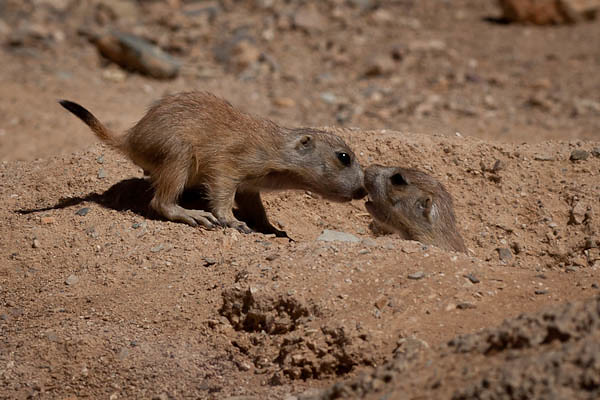Aren’t they cute? These prairie dog babies are about six weeks old, and it was only their second day out in the sun. Their mama had kept them safely in their nesting burrow until they were ready to meet the big world. They rub noses to greet each other, to say “hello”.
Animals aren’t one of my usual subjects, but I was wandering around the Arizona Sonora Desert Museum yesterday. I followed a path I had never been on before, rather amazed that in my dozens of visits to this mecca of desert learning I had never traveled this loop. I found myself in front of a large open exhibit of native black-tailed prairie dogs.
There were maybe fifteen to twenty adults out of their burrows, cavorting in the sun, standing watch, signaling to each other with a variety of calls and shrieks, and in general doing the animal things they do. One of the more interesting gestures I observed was a leap in the air from an alert standing position accompanied by a shriek – evidently an “all clear” signal. An attention getter, for sure.
It was a hot day and when I spotted an area of shade with an inviting bench, I stopped for a sit in the shade. Two nearby docents were discussing the prairie dogs with a couple from British Columbia, and it was evident from their exuberant commentary that they were true fans of these Prairie Dogs. In a few minutes I found out a huge amount of information:
- Prairie dogs were once a common animal on the US Plains and in the western states, but eradication by ranchers, hunters, and state and national groups has reduced their populations to 1% of their original numbers.
- In the 1970s it was erroneously reported that 250 prairie dogs could eat the equivalent amount of grass that one cow consumed, and so systematic poisoning was undertaken.
- There was no any scientific proof that the prairie dogs interfered with the feeding of cattle. Instead, it has been found that the prairie dogs and cattle have co-existed for hundreds of years, as each prefers different grasses. Nonetheless, the myth remains and though prairie dogs populations continue to decline, they are not a protected species. Instead they continue to be needlessly killed.
- The black-tailed prairie dog is the predominant prey for the black-footed ferret, once considered extinct until a small number were found in Wyoming. The black-footed ferret is prey for some of the threatened populations of falcons. Lose one species, lose others, too.
- Just one more example of messing with the food chain. When one animal becomes extinct, suddenly it affects the status of many other animals. Makes one wonder how many kinds of animals can be forever lost to the earth before it has a detrimental impact on human existence.
I certainly didn’t expect to learn all that information (and much more) on my ten minute sit, but the docents were interesting, knowledgeable, and showed true compassion and caring for the animals in their care.
(Most of the animals at the Desert Museum, especially the larger mammals such as the mountain lion and black bear, are in this environment because they were rehabbed and are unable to live in the wild.)
—————–
Bo Mackison is a photographer and owner of Seeded Earth Studio LLC, living and photographing in southern Arizona until April’s end. Then she will return to her Midwest home where it is currently cloudy and the high is expected to near 45˚F.








Very interesting post & very cute babies.
Cute, they certainly are!